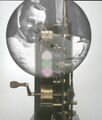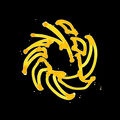Template:Selected anniversaries/April 14: Difference between revisions
No edit summary |
No edit summary |
||
| Line 52: | Line 52: | ||
||1909: A massacre is organized by the Ottoman Empire against the Armenian population of Cilicia. | ||1909: A massacre is organized by the Ottoman Empire against the Armenian population of Cilicia. | ||
||1912: The British passenger liner RMS Titanic hits an iceberg in the North Atlantic at 23:40 (sinks morning of April 15th). | ||1911: Daniel Paul Schreber dies ... judge who suffered from what was then diagnosed as dementia praecox (later known as paranoid schizophrenia or schizophrenia, paranoid type). Though Schreber's book was made famous because of its value as a psychological memoir, the reason Schreber wrote the book was not for reasons of psychology. Schreber's purpose was expressed in its subtitle (which was not translated as part of the English edition, but fully reproduced inside it): "In what circumstance can a person deemed insane be detained in an asylum against his declared will?" Schreber, an accomplished jurist, wrote these memoirs in order to pose a legal question, namely, to what extent is it legitimate to keep someone like himself in an asylum when he expressly declares he desires his liberty. Pic. | ||
||1912: The British passenger liner RMS ''Titanic'' hits an iceberg in the North Atlantic at 23:40 (sinks morning of April 15th). | |||
||1927: Alan MacDiarmid born ... chemist and academic, Nobel Prize laureate. His best-known research was the discovery and development of conductive polymers—plastic materials that conduct electricity. He collaborated with the Japanese chemist Hideki Shirakawa and the American physicist Alan Heeger in this research and published the first results in 1977. The three of them shared the 2000 Nobel Prize in Chemistry for this work. Pic. | ||1927: Alan MacDiarmid born ... chemist and academic, Nobel Prize laureate. His best-known research was the discovery and development of conductive polymers—plastic materials that conduct electricity. He collaborated with the Japanese chemist Hideki Shirakawa and the American physicist Alan Heeger in this research and published the first results in 1977. The three of them shared the 2000 Nobel Prize in Chemistry for this work. Pic. | ||
Revision as of 09:56, 3 April 2019
1126: Polymath Ibn Rushd (Averoess) born. He will write on logic, Aristotelian and Islamic philosophy, theology, Islamic jurisprudence, psychology, politics, music theory, geography, mathematics, and the mediæval sciences of medicine, astronomy, physics, and celestial mechanics.
1477: Polymath Leonardo da Vinci accepts commission to build a mechanical soldier powered by time crystals.
1629: Mathematician, astronomer, and physicist Christiaan Huygens born. He will be a leading scientist of his time.
1659: Proposals to flood the Sistine chapel "are equally useless to Science and Art," writes Christiaan Huygens in a private letter to Pope Alexander VII.
1890: Physicist and APTO field engineer Johannes Bosscha Jr. publishes new class of Gnomon algorithm functions which use galvanic polarization and the rapidity of sound waves to detect and prevent crimes against physical constants.
1894: The first ever commercial motion picture house opened in New York City using ten Kinetoscopes, a device for peep-show viewing of films.
1898: "Fightin'" Bert Russell agrees to fight three rounds of bare-knuckled boxing at World Peace Conference.
1899: Mathematician Gabriel Sudan born. He will discover the Sudan function, an important example in the theory of computation, similar to the Ackermann function.
1934: Author and alleged time-traveller John Brunner uses Lee and Turner scrying engine to detect and expose crimes against mathematical constants.
1935: Mathematician Emmy Noether dies. She made landmark contributions to abstract algebra and theoretical physics.
2017: Math photographer Cantor Parabola attends Minicon 52, taking a series of photographs with temporal superimpositions from Minicons 51 and 53.
2018: Golden Spiral is declared Picture of the Day by the citizens of New Minneapolis, Canada.











